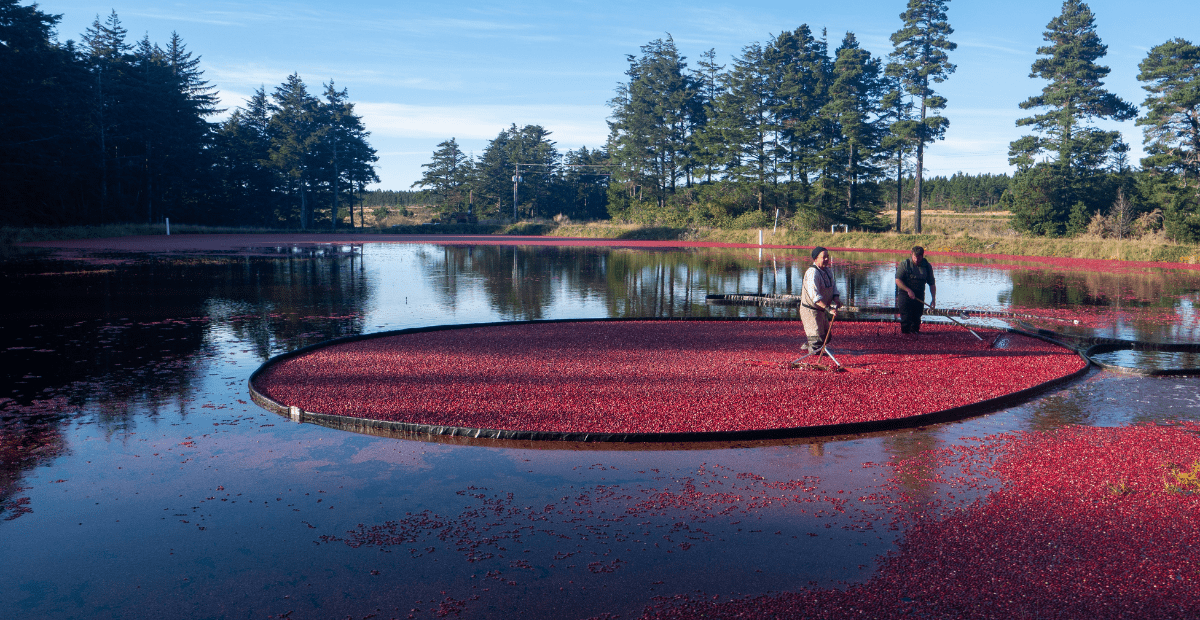Cranberry bogs have some surprising tenants, and those are wolf spiders. Are they a plague? is it intentional? Read this post and find out!
What are cranberry bogs
Cranberry bogs, also known as cranberry marshes, are agricultural systems designed to cultivate cranberries. Cranberries are a type of tart, red berry that is native to North America. Their harvest is usually in the fall.
Cranberry bogs are typically located in wetlands or other areas with acidic soil and abundant water resources. The bogs are flooded with water to create a shallow pool, and then cranberry vines are planted in the soil. The vines grow and spread along the ground, producing berries that float on the surface of the water.

When it’s time to harvest the cranberries, the bogs are flooded with water again. Then special equipment is used to remove the berries from the vines. The floating cranberries are corralled into one area. After that, they are harvested with machines that gently remove the berries from the water.

Farmers can then sell the harvested cranberries fresh or use them to make cranberry juice, sauce, and other products.
Cranberry bogs are an important agricultural industry in parts of North America, Particularly in the northeastern United States and southeastern Canada.
What are wolf spiders doing in cranberry bogs?

Cranberry farmers often use Wolf spiders as a form of natural pest control in cranberry bogs because they are effective predators of insect pests that can damage cranberry crops.
Cranberry bogs are vulnerable to a range of insect pests, including cranberry fruit worms and cutworms. These pests can cause significant damage to cranberry plants and reduce crop yields. Wolf spiders are natural predators of these insect pests, as well as other small insects and spiders.

Photo by Gecko gr, CC BY-SA 4.0, via Wikimedia Commons
Wolf spiders are particularly well-suited to cranberry bogs because they are able to move quickly across the bog’s sandy soil and are not deterred by the standing water that is present in many bogs.
Using wolf spiders as a form of natural pest control can be an effective way to reduce the use of chemical pesticides and promote a more sustainable approach to agriculture.
What are wolf spiders?

Wolf spiders are a type of arachnid that belong to the family Lycosidae. Their name comes from their hunting behavior, which is similar to that of wolves, in that they chase and capture their prey rather than spinning webs to trap it.
You can come across Wolf spiders throughout the world. They come in a variety of sizes and colors and typically have eight eyes arranged in three rows, with the two largest eyes in the front row providing excellent vision. You can recognize them by their powerful legs, which allow them to run quickly and jump far distances.
Despite their intimidating appearance, most wolf spiders are not harmful to humans. However, some species can deliver a painful bite if they feel threatened, although their venom is generally not dangerous. People should consider Wolf spiders beneficial because they prey on a variety of insects, including pests that can damage crops and gardens.
Are there other animals in cranberry bogs?
The answer is yes, Wolf spiders aren’t the only animals you can encounter when visiting a cranberry bog. According to Charles Armstrong, a Cranberry Professional from the University of Maine, cranberry bogs are fascinating ecosystems that support a wide range of wildlife. These areas, which include wetlands, uplands, ditches, flumes, ponds, and other water bodies, create diverse habitats for many species.

Charles shares that common animals in and around cranberry bogs include otters, beavers, and muskrats. You may spot otters swimming and hunting in the water, while beavers build dams that can change the flow of water, creating new wetland areas. Muskrats, smaller than beavers, build burrows along the water’s edge.
Bird life is abundant in cranberry bogs as well. Great blue herons wade through the water in search of fish, while wood ducks nest in the trees and feed on aquatic plants and insects. You can often catch ospreys, flying overhead, and looking for fish in the water below. If you want to do some bird watching in cranberry bogs, you can check out the Cranberry Pond “the perfect bed & breakfast destination for avid birdwatchers!“
Also, Charles explains that it’s not just animals, cranberry bogs also support a wide variety of plants, including water lilies, meadow beauty, and loosestrife. The unique combination of water bodies and surrounding landscapes makes cranberry bogs important not only for agriculture but also as habitats for many different species, demonstrating their value in both natural and managed environments.
In conclusion
If you are planning a trip to the cranberry bog this fall, be aware of the wolf spiders! They are not a plague but instead perform a very important job at the cranberry bogs.
If you are interested in interesting facts like these you may be interested in the following posts:


2 responses to “Bet you didn’t know cranberry bogs are filled with wolf spiders”
[…] Bet you didn’t know cranberry bogs are filled with wolf spiders […]
[…] Bet you didn’t know cranberry bogs are filled with wolf spiders […]